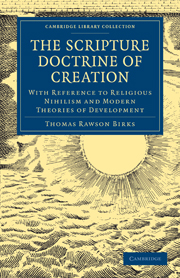 The Scripture Doctrine of Creation
The Scripture Doctrine of Creation Published online by Cambridge University Press: 29 August 2010
The Bible, in its very first word, affirms a beginning. Science also, when closely examined, points not obscurely to the same truth. Both exclude, as a mere figment, the idea of a succession of past ages of time, strictly infinite, a view which strives to escape from a divine mystery, only to involve us in a direct contradiction of sound reason. But the second word of the same message affirms an act of divine power, by which the universe came first into being. This assertion may be viewed separately, as it refers to lifeless matter, or to all the forms of life, ascending from the lowest to the highest. In each aspect it is opposed to the Materialism, which claims the self-existence for matter, by faith ascribed to God only; and to the Nihilism, which denies that of God and creation any thing whatever can be known.
The doctrine of Scripture is plain. Matter was created, and began to be. Its existence is due to the will and fiat of the Creator, the I AM, the self-existent and all-perfect being “All things were made by Him, and without Him was not any one thing made, that is made.” “He spake, and it was done,” and “by Him all things consist.” The course of reasoning also is brief and plain. We are conscious of our own existence, and know also, by perception, the existence of things around us, and of a material world.
To save this book to your Kindle, first ensure [email protected] is added to your Approved Personal Document E-mail List under your Personal Document Settings on the Manage Your Content and Devices page of your Amazon account. Then enter the ‘name’ part of your Kindle email address below. Find out more about saving to your Kindle.
Note you can select to save to either the @free.kindle.com or @kindle.com variations. ‘@free.kindle.com’ emails are free but can only be saved to your device when it is connected to wi-fi. ‘@kindle.com’ emails can be delivered even when you are not connected to wi-fi, but note that service fees apply.
Find out more about the Kindle Personal Document Service.
To save content items to your account, please confirm that you agree to abide by our usage policies. If this is the first time you use this feature, you will be asked to authorise Cambridge Core to connect with your account. Find out more about saving content to Dropbox.
To save content items to your account, please confirm that you agree to abide by our usage policies. If this is the first time you use this feature, you will be asked to authorise Cambridge Core to connect with your account. Find out more about saving content to Google Drive.